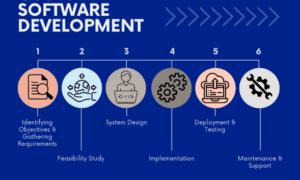In the modern business landscape, ERP software development services have become a cornerstone for organizations seeking to integrate, automate, and optimize their operations. Enterprise Resource Planning (ERP) systems unify diverse processes—finance, human resources, supply chain, inventory, sales, customer relations—into a single cohesive platform. For businesses that aim to scale efficiently, improve decision-making, and eliminate silos between departments, ERP software development provides the technological backbone necessary for sustained growth and digital transformation.
1. Understanding ERP Software Development
At its core, ERP software development is about designing and building integrated systems that centralize organizational data and workflows. Unlike off-the-shelf software, custom ERP solutions are tailored to a company’s specific processes, goals, and challenges.
ERP software typically encompasses modules for accounting, procurement, inventory management, production planning, human resources, customer relationship management (CRM), and analytics. The strength of ERP lies in how these modules interact seamlessly, sharing real-time data and insights across the organization.
Key Components of ERP Software:
- Financial Management: Automates billing, budgeting, and financial reporting.
- Human Resources Management: Streamlines payroll, attendance, performance evaluation, and recruitment.
- Inventory and Supply Chain Management: Tracks stock levels, purchase orders, logistics, and vendor performance.
- Sales and CRM: Manages leads, customer communication, and sales forecasts.
- Production and Manufacturing: Schedules operations, manages resources, and monitors product lifecycle efficiency.
- Analytics and Reporting: Provides dashboards and insights for data-driven decision-making.
By consolidating these functionalities, ERP development ensures that all business units work from a unified data source—improving accuracy, visibility, and operational agility.
2. Why Businesses Invest in ERP Software Development
Companies adopt ERP systems for a variety of reasons, but most share common goals: increasing efficiency, reducing costs, and improving collaboration. As businesses grow, managing complex processes across multiple departments becomes increasingly difficult with disparate systems. ERP eliminates this fragmentation.
Key Benefits Include:
- Process Automation: Reduces repetitive manual tasks, improving productivity and consistency.
- Data Accuracy: Ensures real-time, reliable data flow between departments.
- Scalability: Adapts to changing business needs and future growth.
- Compliance and Reporting: Simplifies adherence to industry regulations with built-in compliance features.
- Customer Satisfaction: Provides faster, more accurate service through integrated CRM functions.
- Strategic Decision-Making: Empowers leadership with actionable insights through analytics and forecasting.
For organizations in manufacturing, retail, logistics, healthcare, and finance, a well-designed ERP system is more than software—it’s a strategic asset.
3. Custom vs. Off-the-Shelf ERP Solutions
One of the most critical decisions in ERP software development is choosing between a custom-built system and an off-the-shelf solution.
Custom ERP Software:
Custom ERP software is designed from the ground up to align perfectly with an organization’s unique processes. It offers flexibility, scalability, and complete control over features, integrations, and user experience.
Advantages:
- Tailored to specific workflows and business models.
- Easier integration with legacy systems.
- High adaptability for future needs.
- Competitive differentiation through proprietary features.
Disadvantages:
- Higher initial development cost.
- Longer time to deploy.
- Requires ongoing maintenance and support.
Off-the-Shelf ERP Software:
Off-the-shelf ERP products (like SAP, Oracle NetSuite, or Microsoft Dynamics) are prebuilt solutions designed to meet general industry requirements.
Advantages:
- Faster deployment and lower upfront cost.
- Tested and proven reliability.
- Regular vendor updates and support.
Disadvantages:
- Limited customization options.
- Licensing and subscription costs can accumulate.
- May require businesses to adapt their processes to fit the software.
For businesses with unique workflows or complex integration needs, custom ERP software development services often provide better long-term value.
4. The ERP Software Development Lifecycle
Developing an ERP system involves multiple stages, each essential for delivering a high-quality, scalable solution.
1. Requirement Analysis
This phase begins with understanding business processes, challenges, and goals. Developers and stakeholders collaborate to define system modules, integrations, user roles, and performance expectations.
2. System Design
The architecture is planned—defining the database structure, technology stack, user interfaces, and data flow. The system design ensures scalability, security, and compliance from the outset.
3. Development and Coding
This stage involves programming backend logic, developing APIs, and creating front-end interfaces. Agile methodologies are often employed to deliver functionality incrementally and incorporate client feedback continuously.
4. Integration
ERP must integrate with other business tools like CRM systems, e-commerce platforms, or payment gateways. Seamless integration ensures data consistency and interoperability.
5. Testing and Quality Assurance
Thorough testing—including unit, integration, security, and performance testing—ensures that the ERP performs reliably under real-world conditions.
6. Deployment
Once tested, the ERP system is deployed in the production environment. Developers monitor performance closely during rollout to address any issues swiftly.
7. Training and Support
User adoption is critical. Comprehensive training ensures employees use the system effectively. Ongoing support and maintenance keep the ERP optimized and secure.
5. Key Technologies in ERP Software Development
Modern ERP development leverages cutting-edge technologies to enhance system functionality and user experience.
Cloud Computing
Cloud-based ERP solutions offer flexibility, scalability, and lower infrastructure costs. They enable access from any location and support real-time collaboration across global teams.
Artificial Intelligence (AI) and Machine Learning (ML)
AI-powered analytics and automation optimize forecasting, demand planning, and decision-making. ML algorithms detect patterns, predict outcomes, and provide actionable insights.
Internet of Things (IoT)
IoT integration in ERP allows real-time tracking of assets, equipment, and production data, particularly valuable in manufacturing and logistics industries.
Blockchain
Blockchain enhances transparency, data integrity, and traceability in ERP systems—especially for supply chain and financial operations.
Big Data and Analytics
ERP systems harness big data to generate predictive insights, enabling organizations to anticipate trends and make proactive decisions.
Mobile Accessibility
With remote work and field operations on the rise, mobile ERP solutions ensure employees can access real-time data anytime, anywhere.
Low-Code and No-Code Development
These platforms allow faster ERP customization with minimal manual coding, reducing development time and increasing agility.
6. Challenges in ERP Software Development
While ERP development brings immense value, it also comes with inherent challenges that must be managed strategically.
- Complexity of Integration: Integrating various modules and third-party tools can be technically demanding.
- Data Migration: Transferring large volumes of legacy data accurately requires meticulous planning.
- User Resistance: Employees may resist change without proper training and communication.
- Budget Overruns: Custom ERP projects may exceed costs if requirements are not clearly defined.
- Security Risks: ERP systems handle sensitive business data, making cybersecurity a top priority.
- Maintenance and Upgrades: Continuous optimization is essential to ensure performance and compliance.
Overcoming these challenges requires experienced developers, strategic planning, and strong collaboration between technical teams and business stakeholders.
7. Best Practices for ERP Software Development
To ensure the success of ERP implementation, development teams follow industry best practices:
- Define Clear Objectives: Establish measurable goals aligned with business strategy.
- Choose the Right Technology Stack: Select scalable frameworks and databases that support long-term growth.
- Prioritize User Experience: Design intuitive interfaces that simplify daily tasks for end users.
- Implement in Phases: A modular rollout reduces risk and allows incremental improvements.
- Ensure Data Security: Implement multi-factor authentication, encryption, and regular audits.
- Continuous Feedback Loop: Gather feedback from users to refine workflows and enhance system performance.
- Comprehensive Documentation: Maintain detailed records for system architecture, integrations, and processes.
These practices not only improve system quality but also foster higher user adoption rates and ROI.
8. ERP Software Development Services for Different Industries
ERP systems are versatile, with industry-specific customizations to meet unique operational requirements.
Manufacturing
Manufacturing ERP software manages production scheduling, supply chain, and quality control. Integration with IoT sensors enables real-time monitoring of equipment efficiency.
Retail and E-Commerce
ERP streamlines inventory management, order fulfillment, pricing, and customer data synchronization across channels.
Healthcare
Healthcare ERP solutions integrate patient records, billing, inventory, and compliance management to enhance patient care and operational transparency.
Construction
ERP helps track project progress, allocate resources, and manage contracts efficiently across multiple sites.
Education
ERP systems for schools and universities manage admissions, finance, course scheduling, and student performance tracking.
Finance
Financial ERP platforms automate accounting, risk management, and compliance reporting while maintaining strict security standards.
Each industry benefits from ERP systems tailored to its unique challenges and workflows, emphasizing how essential ERP software development services are for digital transformation.
9. Trends Shaping the Future of ERP Software Development
The ERP landscape is continuously evolving. Emerging technologies and market demands are driving new innovations.
- AI-Driven Decision Support: Predictive analytics and AI assistants are transforming decision-making.
- Hyper-Personalization: ERP systems are adapting to user preferences for enhanced usability.
- SaaS and Subscription Models: Cloud ERP adoption continues to rise due to its affordability and accessibility.
- Integration with Collaboration Tools: Modern ERPs now integrate with tools like Slack, Microsoft Teams, and Trello.
- Green ERP: Focus on sustainability and reducing environmental impact through efficient resource management.
- Microservices Architecture: Breaking ERP systems into modular components for greater scalability and flexibility.
Businesses that embrace these trends position themselves ahead in efficiency, agility, and competitiveness.
10. Choosing the Right ERP Development Partner
Selecting the right ERP development company is crucial to achieving desired outcomes. Key criteria include:
- Experience and Expertise: Proven track record in developing ERP solutions across industries.
- Technical Proficiency: Mastery in relevant programming languages, databases, and frameworks.
- Understanding of Business Processes: Ability to translate organizational needs into technical requirements.
- Post-Deployment Support: Continuous maintenance and training for smooth operations.
- Security and Compliance Knowledge: Awareness of industry-specific regulations like GDPR, HIPAA, or ISO standards.
A reliable development partner not only builds software but also provides strategic guidance throughout the ERP lifecycle.
11. The Business Impact of Effective ERP Implementation
When implemented effectively, ERP systems transform how businesses operate and compete.
- Operational Efficiency: Reduced redundancy and improved coordination across departments.
- Cost Reduction: Streamlined processes and automation lower operational costs.
- Faster Decision-Making: Centralized data enables quick access to insights.
- Improved Collaboration: Departments work cohesively with shared information.
- Scalable Growth: ERP systems evolve with the business, supporting expansion and innovation.
Ultimately, ERP software development is an investment in long-term success—a tool that empowers organizations to navigate complexity with precision.
Conclusion
In an era defined by digital transformation and data-driven operations, ERP software development services are indispensable for organizations striving to unify processes, improve visibility, and gain a competitive edge. Whether through custom-built systems or cloud-based solutions, ERP empowers businesses to automate, analyze, and adapt with agility. The journey from planning to deployment requires expertise, collaboration, and vision—but the rewards are significant: streamlined operations, informed decision-making, and sustainable growth. As industries evolve, ERP software will continue to serve as the digital foundation for intelligent, integrated enterprises of the future.



































